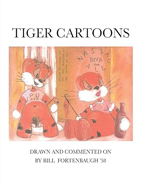
 |
Fortenbaugh’s collection of cartoons always depicts the characters as tigers. This arises from the fact that Fortenbaugh was an undergrad at Princeton University, which has a tiger as a mascot. The cartoons he captions and illustrates are mostly dominated by happenings at Princeton or family matters. The Princeton issues cover many things ranging from campus life, wrestling (and the near termination of that program), and reunions. The family memories include his marriage to his wife, Connie, the births and accomplishments of their children and grandchildren, their own anniversaries, and recent Christmas cards. Fortenbaugh mentions that many of the early drawings, particularly in relation to Christmas cards, have been lost over the years. Through the comics, readers see the Fortenbaugh couple travel together through the changes that come from raising a family and growing older together. What is learned is that this is a loving family, with their own ups and downs, who have a lifelong connection to Princeton, display a sense of humor, and enjoy time visiting with former classmates.
Viewing the cartoons from the earliest to the latest shows how Fortenbaugh refined his style over the years but didn’t make major changes. This is a trait that many cartoonists whose work spans decades have in common. The tigers are more friendly than fierce, and a chipmunk is once mentioned in comparison, which isn’t far from what is seen. The clothing and peripherals seem to become more detailed as he continues to draw. Most readers will likely either think of the classic Calvin and Hobbes cartoons by Bill Watterson or the more recent Daniel Tiger show created by Angela Santomero when first thinking about a tiger cartoon. However, Fortenbaugh diverges from both of these in significant ways. His cartoons are more centered on older people as well as the passage of time and its effect on the family rather than a young boy’s adventures, whether animated or with his tiger friend. Also, Fortenbaugh is less concerned with telling an extended story in a serial way. Instead, his cartoons are centered on capturing a specific moment in time, encapsulating it in a manner more closely related to a single photograph or even a souvenir postcard.
What Fortenbaugh manages to capture in his decades-spanning cartoons are snapshots of a life well-lived, full of family warmth, growth, and loyalty to an alma mater. Each cartoon has a description of what is being depicted, often giving more historical information when concerning Princeton or an extended personal story on the more familial illustrations. These comments add to the understanding of the narrative and build the connections between the comics, the era represented, and the people involved. They are all easy to read and grammatically clean. Because of its narrow focus, his collection is less about reaching and entertaining a large audience of readers than it is about collecting the work of a family man for his children and their future generations' consumption. However, it will also likely interest those who enjoy historical cartoons or have a personal connection to Princeton University and are interested in its history.